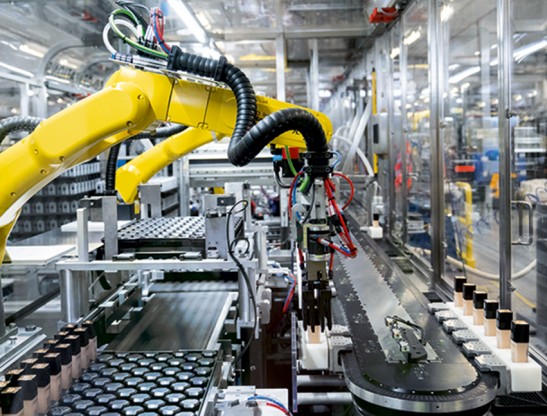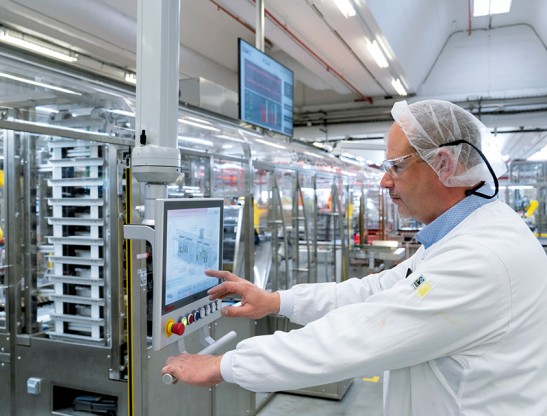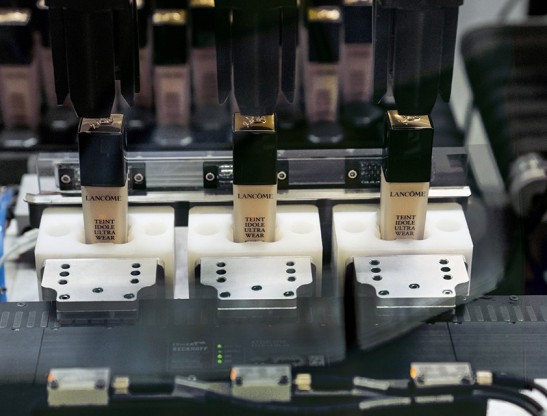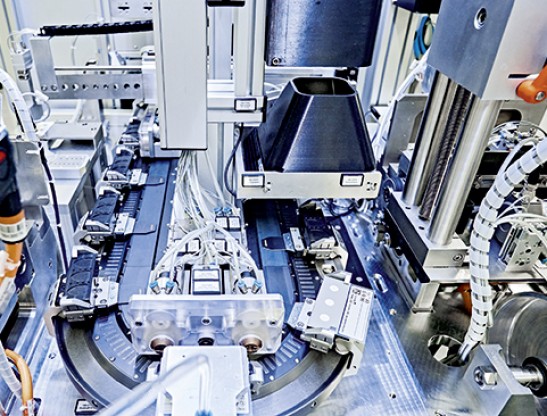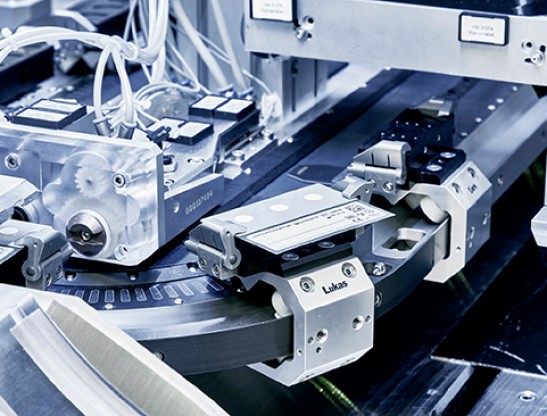L’Oréal uses intelligent product transport to improve the flexibility in cosmetics filling operations
XTS at the core of a new solution
The new system layout is based on an XTS with a circumferential track length of 22 meters and with 40 movers as its core element. The various stations for filling the make-up foundations are arranged along the intelligent transport system. The filling process includes six work steps: infeed of the bottles, filling, adding dispenser pumps, caps and labels, and outfeed of the finished products. For infeed a handling robot is used, which takes two or three empty bottles from a tray and places them into transport containers fastened on the movers. In the following stations, robots or handling systems fill the bottles, insert dispenser pumps or droppers (depending on the product), screw them on, and place a cap on top. Next, a laser code with the color, lot number and expiration date is printed on the bottle and a label is applied. At the end of the XTS circuit, the filled bottles are placed onto trays and forwarded to a cartoner.
Leading edge through reduced system footprint and increased flexibility
A key advantage of the XTS is the individual control of its movers, with each bottle being transported through the processing stations by a single mover. Depending on the required processing time, the mover is able to stop and to accelerate with the bottle after completion in the direction of the next process step. This eliminates the necessity to execute differently timed processing steps on separate machines and to provide complex interfaces and product accumulators between them. Instead, the XTS integrates the previous five machines into a single system. Through this integration and the compact design of the XTS, the system footprint could be reduced by 30%. In combination with the increased output of the system, the productivity per unit area could be increased significantly. In this way, L'Oréal will be able to meet the increasing demand for luxury cosmetics in the future without having to expand its production floor area. The resulting investment security is also protected by another key benefit of the XTS, which is increased flexibility.
Through the software-based control with TwinCAT, the XTS can switch between different product variants by means of the corresponding parameter sets. This capability makes it possible to process different formats on a single line instead of having to use several machines. Another benefit is provided with regard to the production of minimum lot sizes: “In terms of flexibility, the XTS is the core of a new solution that allows us to switch to another color within seconds. This means we can both reduce lot sizes and meet changing customer requirements”, explains Jean Yves Vey, plant manager at the Caudry site. The time needed for format changeovers was cut in half and the system availability was increased. The same line can now produce lot sizes ranging from a few hundred to millions of pieces as well as seven different format types with only 40 instead of 300 transport containers. Jean-Yves Vey also mentions other advantages of the TwinCAT-controlled XTS in connection with quality assurance: “The centralized control principle of the XTS system makes operation, and quality management tasks in particular, much easier. These include sample removal, running the line empty if necessary and checkweighing. All these tasks are fully automated including RFID support.”
L’Oréal Group – Caudry plant
In its Caudry plant in the French Département Nord, the L’Oréal Group produces high-quality skin care products, mascaras and make-up foundations for its Division Luxe. Three of the production lines are already based on the eXtended Transport System (XTS) from Beckhoff. This includes the new Agile F24 filling and capping line, which enables fast format changes with a simultaneously increased output, in line with the corporate strategy to increase the agility of its production operations. In addition, the new system combines the functionality of five previously separate machines on a reduced footprint.
Efficient PSC production with XTS simplifies access to HIV tests
Roche has developed the Cobas Plasma Separation Card (PSC), a new technology that simplifies and improves the examinationand monitoring of HIV patients, particularly in remote areas. For the first time, blood plasma samples no longer need to be cooledduring transport to the laboratory. The prerequisite for this breakthrough was a flexible, compact and dynamic productiontech-nology that allows the PSC to be produced cost-effective. This was realized with the eXtended Transport System (XTS)from Beckhoff, which increases efficiency with its high flexibility.
The PSC is manufactured in a compact machine measuring around 3.5 x 3 m, inwhich the eXtended Transport System (XTS) from Beckhoff plays a central role. It was developed at Roche's Mannheim site by the company’s in-house mechanical engineering specialists in the Manufacturing Service & Technology department. Lukas Nagel, Specialist Engineer at Roche, explains that experts from development and production worked hand in hand, so that the project could be completed in just two years until it was ready for production. XTS played an important role as a highly flexible transport system, as it allowed the production unit to be adapted to changing requirements during the development process. Process optimizations can be implemented rapidly using the software-based functionality, which is easy to modify.


